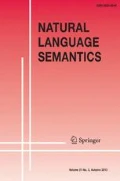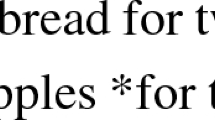Abstract
To what extent are countability distinctions subject to systematic semantic variation? Could there be a language with no countability distinctions—in particular, one where all nouns are count? I argue that the answer is no: even in a language where all NPs have the core morphosyntactic properties of English count NPs, such as combining with numerals directly and showing singular/plural contrasts, countability distinctions still emerge on close inspection. I divide these distinctions into those related to sums (cumulativity) and those related to parts (divisiveness, atomicity, and related notions). In the Sahaptian language Nez Perce, evidence can be found for both types of distinction, in spite of the absence of anything like a traditional mass–count division in noun morphosyntax. I propose an extension of the Nez Perce analysis to Yudja (Tupí), analyzed by Lima (The grammar of individuation and counting, 2014) as lacking any countability distinctions. More generally, I suggest that at least one countability distinction may be universal and that languages without any countability distinctions may be unlearnable.
Similar content being viewed by others
References
Aoki, Haruo. 1994. Nez Perce dictionary. Berkeley: University of California Press.
Aoki, Haruo, and Deward Walker. 1989. Nez Perce oral narratives. Berkeley: University of California Press.
Bale Alan, David Barner (2009) The interpretation of functional heads: Using comparatives to explore the mass/count distinction. Journal of Semantics 26: 217–252
Barner David, Jesse Snedeker (2005) Quantity judgments and individuation: Evidence that mass nouns count. Cognition 97: 41–66
Barwise John, Robin Cooper (1981) Generalized quantifiers and natural language. Linguistics and Philosophy 4: 159–219
Borer, Hagit. 2005. In name only. Oxford: Oxford University Press.
Bresnan Joan (1973) Syntax of the comparative clause construction in English. Linguistic Inquiry 4: 275–343
Bunt, Harry C. 1985. Mass terms and model-theoretic semantics. Cambridge: Cambridge University Press.
Cheng, C.Y. 1973. Response to Moravscik. In Approaches to natural language, ed. Jaakko Hintikka, Julius Moravcsik, and Patrick Suppes, 286–288. Dordrecht: Reidel.
Cheng Lisa, Lai Shen, Rint Sybesma (1998) Classifiers and massifiers. Tsing Hua Journal of Chinese Studies 28: 385–412
Cheung, Pierina, Peggy Li, and David Barner. 2010. Individuation and quantification: Do bare nouns in Mandarin Chinese individuate? In Proceedings of the 22nd North American conference on Chinese Linguistics, ed. L.E. Clemens and C.-M. Liu, 395–412. Cambridge, MA: Harvard University.
Chierchia, Gennaro. 1994. Syntactic bootstrapping and the acquisition of noun meanings: The mass–count issue. In Syntactic theory and first language acquisition: Crosslinguistic perspectives, ed. Barbara Lust et al., 301–318. Mahwah, NJ: Lawrence Erlbaum Associates.
Chierchia, Gennaro. 1998a. Plurality of mass nouns and the notion of “semantic parameter”. In Events and grammar, ed. Susan Rothstein, 53–104. Dordrecht: Kluwer.
Chierchia Gennaro (1998b) Reference to kinds across languages. Natural Language Semantics 6: 339–405
Chierchia Gennaro (2010) Mass nouns, vagueness and semantic variation. Synthese 174: 99–149
Chierchia, Gennaro. 2015. How universal is the mass/count distinction? Three grammars of counting. In Chinese syntax in a cross-linguistic perspective, ed. Audrey Li, Andrew Simpson, andWei-Tien Dylan Tsai, 147–175. Oxford: Oxford University Press.
Crook, Harold David. 1999. The phonology and morphology of Nez Perce stress. PhD dissertation, University of California at Los Angeles.
Deal, Amy Rose. 2010. Topics in the Nez Perce verb. PhD dissertation, University of Massachusetts at Amherst.
Deal, Amy Rose. 2015. A note on Nez Perce verb agreement, with sample paradigms. In Proceedings of the international conference on Salish and neighbouring languages 50, ed. Natalie Weber et al., 389–413. Vancouver: UBCWPL.
Deal, Amy Rose. 2016a. Person-based split ergativity in Nez Perce is syntactic. Journal of Linguistics 52: 533–564.
Deal, Amy Rose. 2016b. Plural exponence in the Nez Perce DP: A DM analysis. Morphology 26: 313–339.
Doetjes, Jenny. 1997. Quantifiers and selection. The Hague: Holland Academic Graphics.
Goodman, Nelson. 1951. The structure of appearance. Harvard: Harvard University Press.
Grimm, Scott. 2012. Number and individuation. PhD dissertation, Stanford.
Grimm, Scott, and Beth Levin. 2012. Who has more furniture? An exploration of the bases for comparison. Paper presented at Mass/Count in Linguistics, Philosophy and Cognitive Science Conference, École Normale Supérieure, Paris, France.
Heim, Irene. 2006. Little. In Proceedings of SALT 16, ed. M. Gibson and J. Howell, 35–58. Ithaca, NY: CLC Publications.
Huddleston, Rodney, and Geoffrey K. Pullum (eds.). 2002. The Cambridge grammar of the English language. Cambridge: Cambridge University Press.
Inagaki, Shunji, and David Barner. 2009. Countability in absence of count syntax: Evidence from Japanese quantity judgments. In Studies in language sciences, vol. 8, ed. S. Inagaki et al., 111–125. Tokyo: Kurosio.
Kratzer Angelika (1989) An investigation of the lumps of thought. Linguistics and Philosophy 12: 607–653
Krifka, Manfred. 1989. Nominal reference, temporal constitution and quantification in event semantics. In Semantics and contextual expression, ed. R. Bartsch, J.F.A.K. van Benthem, and P. von Emde Boas, 75–115. Dordrecht: Foris Publications.
Krifka, Manfred. 1995. Common nouns: A contrastive analysis of Chinese and English. In The generic book, ed. Greg Carlson and Francis Jeffry Pelletier, 398–411. Chicago: The University of Chicago Press.
Kurafuji Takeo (2004) Plural morphemes, definiteness, and the notion of semantic parameter. Language and Linguistics 5: 211–242
Landman, Fred. 1991. Structures for semantics. Dordrecht: Kluwer.
Landman, Fred. 2011. Count nouns, mass nouns, neat nouns, mess nouns. In The baltic international yearbook of cognition, logic and communication: Formal semantics and pragmatics. Discourse, context and models, vol. 6, ed. B.H. Partee, M. Glanzberg, and J. Skilters, 1–67. Manhattan, KS: New Prairie Press.
Lima, Suzi. 2014. The grammar of individuation and counting. PhD dissertation, University of Massachusetts at Amherst.
Link, Godehard. 1983. The logical analysis of plurals and mass terms: A lattice-theoretical approach. In Meaning, use and interpretation of language, ed. R. Bäuerle, 302–323. Berlin: DeGruyter.
Mathieu Éric (2012) Flavors of division. Linguistic Inquiry 43: 650–679
McCawley, James D. 1975. Lexicography and the count–mass distinction. In Proceedings of the first annual meeting of the Berkeley Linguistics Society, ed. Cathy Cogen et al. 314–321. Berkeley: Berkeley Linguistics Society.
Nicolas, David. 2002. La distinction entre noms massifs et noms comptables: Aspects linguistiques et conceptuels. Louvain/Paris: Éditions Peeters.
Pelletier, Francis Jeffry. 2012. Lexical nouns are neither mass nor count, but they are both mass and count. In Mass and count across languages, ed. Diane Massam, 9–26. Oxford: Oxford University Press.
Pelletier, Francis Jeffry, and Lenhart Schubert. 1989/2003. Mass expressions. In Handbook of philosophical logic, 2nd ed., vol. 10, ed. F. Guenthner and D. Gabbay, 249–336. Dordrecht: Kluwer.
Pesetsky, David, and Esther Torrego. 2001. T-to-C movement: Causes and consequences. In Ken Hale: A life in language, ed. Michael Kenstowicz, 355–426. Cambridge, MA: MIT Press.
Quine, W.V.O. 1960. Word and object. Cambridge, MA: MIT Press.
Ritter, Elizabeth. 1991. Two functional categories in the noun phrase: Evidence from Modern Hebrew. In Syntax and semantics 25: Perspectives on phrase structure, ed. Stephen Anderson and Susan D. Rothstein, 37–62. New York: Academic Press.
Rothstein Susan (2010) Counting and the mass/count distinction. Journal of Semantics 27: 343–397
Sauerland, Uli. 2003. A new semantics for number. In Proceedings of SALT 13, ed. Robert B. Young and Yuping Zhou 258–275. Ithaca, NY: CLC Publications.
Schwarzschild, Roger. 2011. Stubborn distributivity, multiparticipant nouns and the count/mass distinction. In Proceedings of NELS 39, ed. Suzi Lima et al., 661–678. Amherst, MA: GLSA.
Soja, Nancy N., Susan Carey, and Elizabeth Spelke. 1991. Ontological categories guide young children’s inductions of word meaning: Object terms and substance terms. Cognition 38: 179–211.
ter Meulen, Alice. 1981. An intensional logic for mass terms. Philosophical Studies 40: 105–125.
Wiese Heike, Joan Maling (2005) Beers, kaffi, and schnaps: Different grammatical options for restaurant talk coercions in three Germanic languages. Journal of Comparative Germanic Linguistics 17: 1–38
Author information
Authors and Affiliations
Corresponding author
Rights and permissions
About this article
Cite this article
Deal, A.R. Countability distinctions and semantic variation. Nat Lang Semantics 25, 125–171 (2017). https://doi.org/10.1007/s11050-017-9132-0
Published:
Issue Date:
DOI: https://doi.org/10.1007/s11050-017-9132-0




